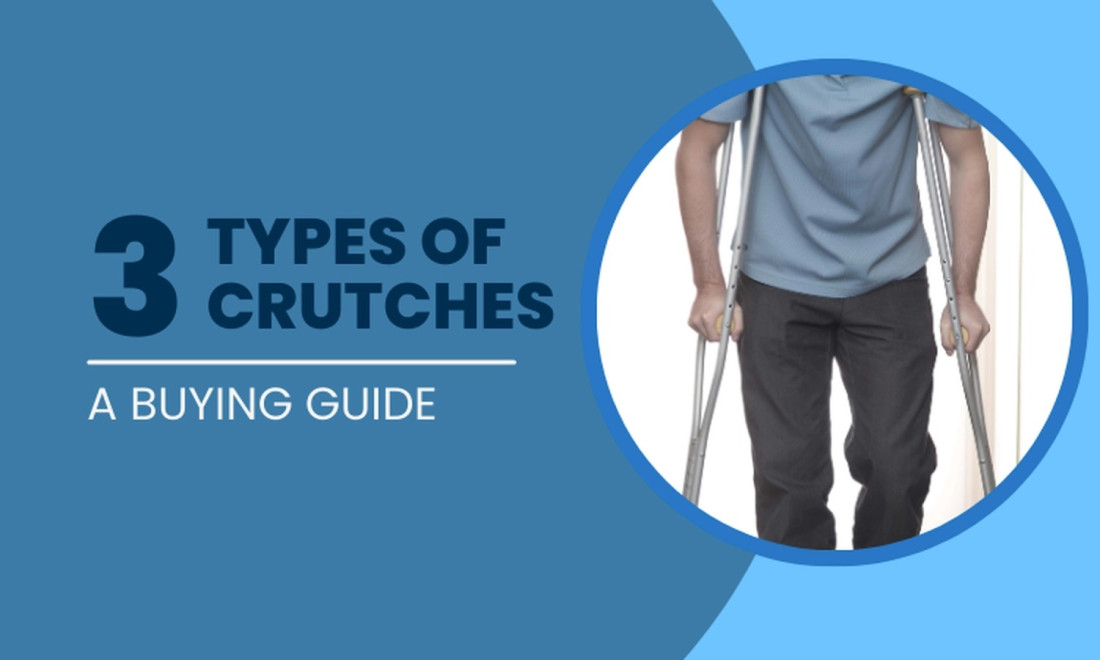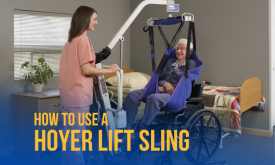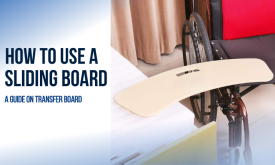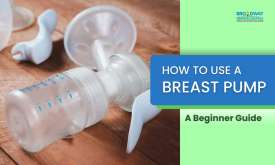Crutches are necessary mobility aids for providing support and help to individuals with various mobility issues. These crutches are used for a short recovery period after surgery, an accident, or a lifelong disability. Although there are three main types of crutches, choosing the right one depends on the cause of the mobility issue, your health condition, and the doctor’s recommendation.
When selecting the ideal crutches, it is crucial to understand the various types and their differences. Let’s dive into the details of three common types of crutches: forearm crutches, underarm crutches, and forearm support crutches, and learn how to make the most suitable choice based on your specific needs.
Underarm Crutches:
Underarm or axillary crutches are one of the most commonly used traditional types. They consist of a padded, U-shaped underarm support that rests against the ribcage and a vertical shaft with a handgrip. These crutches are typically made from lightweight materials like aluminum or wood.
How Do Underarm Crutches Help?
Stability: Underarm crutches provide high stability due to the contact between the underarm and the crutch pad.
Easy to learn: Learning to use underarm crutches is relatively easy, making them a reliable and preferred choice for those new to crutch use.
Adjustable height: Assuring high-level comfort, most underarm crutches are adjustable in height to suit the user’s specific needs.
Things To Keep in Mind
Discomfort: Extended use of underarm crutches can cause discomfort and even nerve damage in the underarm area. Thus, depending on the need and the doctor’s advice, it is ideal to complement the use with some physical exercise to relieve pressure.
Limited mobility: While the crutches are to be used in pairs in alignment with the movement of a lower body part, it is essential to coordinate both crutches and have adequate upper body strength.
Forearm crutches
Forearm crutches or elbow crutches are another common type of crutches used and medically advised. They feature a cuff wrapped around the user’s forearm and a handgrip. Unlike underarm crutches, forearm crutches do not contact the user’s underarms.
How Do Forearm Crutches Help?
Reduced underarm discomfort : Since forearm crutches do not come into contact with the underarms, there are better choices for individuals who find underarm crutches uncomfortable.
More Mobility: With forearm crutches, users are at ease and have a more comprehensive range of motion. These types of crutches allow users to enjoy a more active lifestyle.
Improved Posture: Prominently supporting the forearm, these crutches encourage a more upright posture. The forearm crutches benefit users with back problems by reducing stress on the upper body part.
Things To Keep in Mind
Learning curve: Learning how to use forearm crutches can be more challenging for individuals. Because of its specific design, it requires better balance and coordination.
Less stability: Compared to underarm crutches, the forearm crutches may offer slightly less stability. Particularly for those with severe mobility limitations, it is ideal to consider a doctor’s recommendation before deciding.
Forearm Support Crutches
Forearm support crutches, also called gutter crutches, adjustable arthritic crutches, or platform crutches, combine features of both underarm and forearm crutches. These crutches have an underarm cuff and an extended forearm platform for added support. The forearm support crutches are especially useful for individuals with greater mobility restrictions or those recovering from surgeries or injuries.
How Do Forearm Support Crutches Help?
Enhanced Support: The underarm cuff and forearm platform combination provides exceptional support and stability. This improves comfort while using, making it a promising and efficient mobility aid.
Comfort: The design of the forearm crutches features an extended platform that distributes the user’s weight more evenly, reducing pressure points evenly.
Suitable for various conditions: Featuring a thoughtful design, these crutches are versatile and suitable for a wide range of mobility impairments.
Things To Keep in Mind
Heavier weight: Owing to its special design, the forearm support crutches are generally heavier compared to other types. The additional components used in its design make it more severe than the different types.
Learning curve: The design is a bit complex, eventually adding to the weight. Thus, it may become difficult to learn using forearm crutches.
What Injuries Require Crutches?
Ankle and Feet Injuries
Ankle and foot injuries, including sprains, fractures, ligament tears, etc., are very common. Your ankle and feet are the base on which all your body pressure relies for stability. When injured, putting pressure can delay the recovery and permanently weaken your feet and ankle. Using forearm or underarm crutches can help divide the weight and relieve pressure.
Muscle Sprain and Strains
Muscle sprains and strains can occur anywhere in the body due to excessive muscle use or injury. While it is very common for sports enthusiasts and active people, facing muscle sprains and strains in the leg requires complete rest for faster recovery. Using crutches for mobility can help with certain activities during the recovery period.
Fractures
Fractures, whether major or minor, require time to heal. The doctor might do preventive care and surgery based on the severity of the leg fracture; adding extra support to bring back mobility requires you to use underarm or forearm crutches. The crutches take your body weight and aid faster healing.
Hip Dislocation
Hip dislocation often requires surgery or complete immobilization. Once the healing starts, walking normally without support can strain the injury. Considering the use of a crutch for support aids with easy mobility and independence.
Knee Injury
Knee injuries like ACL injury, dislocation, tears, etc., affect the walking ability, making it difficult to put pressure on the joint. The knee joint is sensitive and needs you to take extra care compared to other leg injuries. Using forearm support crutches or other crutches to support your knee becomes a must.
Other Leg Injuries
Any leg injury related to bones, ligaments, tendons, muscles, etc., related to leg requires aided support for faster recovery and promotes better healing. Forearm and underarm crutches are perfect supports that help improve mobility functions, taking pressure off your leg.
How to Fit Crutches
Properly fitting the crutches is vital to ensure stability and prevent falls. Other than safety, adjusting the crutch as per height and injured leg part helps divide weight equally. Using it incorrectly can cause muscle soreness and pain, which can feel tiring and unpleasant. Here is a guide to properly fit crutches:
How to Fit Underarm Crutches
1. Stand straight without exerting the injured leg much
2. Adjust the height of the underarm crutches according to your height
3. Ensure that the length is 1 to 1.5 inches below your armpit for proper grip
4. Adjust the hand grip and keep it around your hip
5. Your elbow should bend a bit while holding the hand grip for better support
6. Keep the weight on the hand grip and not the underarm to make the best use of underarm crutches
How to Fit Forearm Crutches
1. To fit the forearm crutches, stand straight and adjust the height so the forearm cuff reaches 1 to 2 inches below your elbow
2. The hand support should be around your wrist so that the pressure is on your wrist, not your shoulders or legs
3. Ensure the forearm cuff fits properly, neither loose nor too tight, affecting blood circulation
Safety Tips
1. Always put pressure on the leg that has strength and is not injured
2. To stand using the forearm or underarm crutches, use a tripod position to help create balance
3. Do not put pressure on the injured leg, and neither touch the leg completely on the floor
4. Taking slight support of the injured or weak leg to create balance is fine
5. Put the weight on the crutches and slowly start putting weight on the weak leg as advised by the doctor
6. Bear only as much weight as you can without feeling pain and discomfort
7. Set the crutches according to your height and comfort beforehand
8. Practice and ensure the crutches you use are in proper condition to prevent falls or injuries
Alternatives to Crutches
Wheelchair
Wheelchairs are a simple and common alternative to forearm and underarm crutches, especially when the mobility issue is severe. It even works great when the upper body strength is low, and the wheelchair features can aid independent mobility.
Folding Walker
A folding walker offers a wider base and better support for older people with weaker legs. It helps support post-injury and aging signs. It’s lightweight and easy to store and transport wherever you travel.
Canes
Canes support and offer extra strength to people with weak legs. While it will not help completely immobilize the injured leg, it works when the leg is weak but still able to bear body weight to some extent.
Rollator
Combining the functions of a walker and a wheelchair, a rollator is best for those with limited mobility. Rollators are the perfect support for those who have undergone hip or knee surgery. It has wheels and allows an easy transition from injury to the recovery phase.
Scooters
For a weak lower leg or injury, using a scooter can help. Placing the injured leg on the scooter and the other leg on the ground, you can take small steps and travel using the scooter. The scooter aids mobility and helps relieve the injury for faster recovery.
How Do You Choose the Suitable Crutches?
Selecting the correct type of crutches depends on your individual needs and comfort. Here are some factors to consider:
1. Mobility Level: Determine your level of mobility and choose crutches that provide the required support. Forearm support crutches are generally the most stable option, but underarm or forearm crutches are ideal for those with less severe mobility restrictions.
2. Comfort: Consider any discomfort or pain you are experiencing while using the crutches. If you have issues with pressure on your underarms, forearm crutches or forearm support crutches are more suitable.
3. Physical condition: Assess your upper body strength and balance. Individuals with better upper body strength generally find forearm crutches easier to use.
4. Lifestyle: It is also essential to consider the lifestyle and daily activities. If you lead an active lifestyle, it is ideal to choose forearm crutches as they offer better mobility and posture support.
The choice of crutches plays a critical role in ensuring comfortable and supportive mobility for individuals with various impairments. While underarm crutches, forearm crutches, and forearm support crutches each have their own set of advantages and considerations, the ideal choice depends on your individual needs and preferences. Consulting a healthcare professional or physical therapist to determine the suitable type of crutches for your specific condition proves to be helpful. However, it is also essential to choose quality crutches that ensure long-term, reliable support.
As one of the most reliable medical supply providers, Broadway Medical Supply offers a range of mobility aids, including crutches. Consult with your healthcare professional and explore the range of crutches at Broadway Medical Supply. Enhance your level of comfort and mobility with the most suitable support crutches by Broadway Medical Supply.
Frequently Asked Questions (FAQs)
1. What Does the Patient Need to Know About Walking with the Crutches?
There are different crutches to choose from. Being a patient, you must be comfortable using crutches. Choose underarm or forearm crutches as needed and ensure they support mobility. Adjust the features like height to ensure stability while walking. Ask the healthcare professional to guide you on how to walk comfortably using the crutches. If facing issues or pain in the entire body, try readjusting the use of crutches.
2. Do Crutches Have a Weight Limit?
Different forearms, forearm support, and underarm crutches offer different weight limits. The average capacity is usually 150 lbs. to 500 lbs. Most crutches have a limit of bearing a weight of 300 to 350 lbs. Special crutches with steel bodies can bear a weight of 500 lbs.
3. How Long Do You Need to Use Crutches?
Taking complete care of the injured leg is crucial. Whether using underarm crutches or forearm crutches, it is advised to use them until the doctor has advised. Even if you feel the injury is recovering and you no longer require crutches, always consult before shifting the entire weight on the leg.









